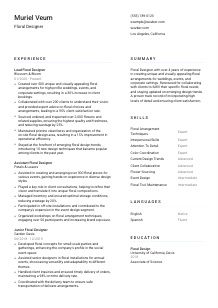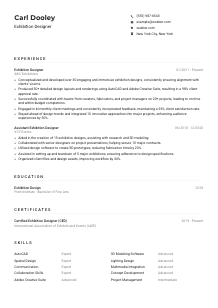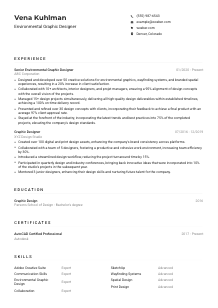Floral Designer Resume Example
Blooming with creativity, but your resume still seems like a bouquet missing its centerpiece? Arrange your credentials with this Floral Designer resume example, designed using Wozber free resume builder. Learn how to showcase your floral finesse to align with job requirements, making your career path as vibrant and beautiful as your arrangements.

How to write a Floral Designer Resume?
Greetings, aspiring Floral Designer! Standing out in a sea of creativity requires more than just talent; it's about presenting your skills and experiences in a way that blooms brightly on paper. Your resume isn't just a document; it's a canvas, showcasing your artistic flair and dedication to the craft. With Wozber's free resume builder, this guide will navigate you through fashioning a resume that's as captivating as your floral arrangements, ensuring it's tailored to your dream job with precision for ATS optimization.
Ready to let your career bloom? Let's dive in and cultivate a resume that places you in your desired Floral Designer role.
Personal Details
Even the most intricate bouquet starts with a single stem. Similarly, your resume begins with the Personal Details section. This is where you lay the foundation, making sure it's rooted in aspects that will catch a recruiter's eye like the vibrant colors of a well-composed floral arrangement.
1. Plant Your Name Boldly
Consider your name the rose in your garden; it should stand out. Employ a clear, professional font, perhaps a tad larger than the rest of the text to ensure it's noticed immediately, much like how a striking flower catches the eye in an arrangement.
2. Align With the Job Title
Embedding the job title 'Floral Designer' beneath your name serves as your resume's botanical label, immediately informing the hiring manager of the position you're vying for and establishing your identity within the floral industry.
3. Cultivate Connection Points
Your contact information is the stem that supports the bloom, enabling hiring managers to reach you. Ensure your phone number is correct and your professional email address follows the 'firstname.lastname@email.com' format. It's simple but necessary for maintaining a direct and clear line of communication.
4. Root Yourself in the Required Location
"Los Angeles, California" isn't just an address—it's an affirmation you meet one of the key criteria by being local, as specified in the job description. It reassures the employer that you're ready to contribute without the complications of relocation.
5. Prune Unnecessary Details
Avoid bloating your resume with personal details that aren't relevant or could lead to unconscious bias, such as age, gender, or marital status. Like a florist removing excess foliage to let the flowers stand out, keep your resume focused on the essentials.
Takeaway
The Personal Details section is the first bloom your prospective employer will see. It sets the stage for the narrative of your professional journey, so it's crucial to ensure it's both professional and aligned with the job requirements. First impressions matter, so make it count with clarity and relevance.





Experience
In the realm of Floral Design, your experience is your bouquet; it showcases the variety, color, and depth of your expertise. This segment tells stories of your arrangements, collaborations, and the vibrant moments you've brought to life through your designs.
- Created over 500 unique and visually appealing floral arrangements for high‑profile weddings, events, and corporate settings, resulting in a 30% increase in client bookings.
- Collaborated with over 200 clients to understand their vision and provided expert advice on floral choices and arrangements, leading to a 95% client satisfaction rate.
- Sourced, ordered, and inspected over 2,000 flowers and related supplies, ensuring the highest quality and freshness, and reducing wastage by 25%.
- Maintained pristine cleanliness and organization of the on‑site floral design area, resulting in a 15% improvement in operational efficiency.
- Stayed at the forefront of emerging floral design trends, introducing 10 new design techniques that became popular among clients in the past year.
- Assisted in creating and arranging over 300 floral pieces for various events, gaining hands‑on experience in diverse design styles.
- Played a key role in client consultations, helping to refine their vision and translate it into unique floral compositions.
- Managed inventory and ensured optimal storage conditions, reducing wastage by 20%.
- Participated in off‑site installations and contributed to the company's expansion in the event design segment.
- Organized workshops on floral arrangement techniques, engaging over 50 participants and increasing brand exposure.
- Developed floral concepts for small‑scale parties and gatherings, enhancing the company's profile in the social event space.
- Assisted senior designers in floral installations for annual events, showcasing versatility and adaptability to different themes.
- Handled client inquiries and ensured timely delivery of orders, maintaining a 98% on‑time delivery rate.
- Coordinated with the delivery team to ensure safe transportation of delicate arrangements.
- Conducted routine maintenance of floral tools, prolonging tool life by 20%.
1. Dissect the Requirements
First, analyze the job listing to identify key responsibilities and skills required. For instance, creating arrangements for weddings and collaborating with clients are highlighted needs. This understanding will help you select experiences from your career that align perfectly, like choosing flowers for a bouquet.
2. Arrange Your Roles Chronologically
Begin with your most recent role, akin to placing the freshest flowers at the forefront of your display. For each position, include your job title, the name of the establishment, and the tenure, establishing a timeline that narrates your growth in the floral industry.
3. Detail Your Achievement Petals
Under each role, articulate your accomplishments and responsibilities that echo the job description. For example, "Created over 500 unique and visually appealing floral arrangements" directly corresponds to the job's demand for creating unique floral designs for events.
4. Quantify Your Blossoms
Numbers add texture and depth, much like the varied layers in a floral arrangement. Whenever possible, quantify your achievements. A statement like "resulting in a 30% increase in client bookings" adds a tangible measure to your impact.
5. Prune Accordingly
Keep only the most relevant experiences in view, trimming away anything that doesn't directly relate to the role of a Floral Designer. This focus ensures every detail on your resume contributes to the overall picture of your suitability for the job.
Takeaway
Think of your experience section as the main arrangement of your resume bouquet. Each role you've played contributes to a narrative that illustrates your journey and your unique fit for the role. Ensure your experiences are displayed thoughtfully, drawing attention to your credentials and blooming history in the floral design industry.
Education
In the garden of your career, education acts as the soil, nurturing your foundational knowledge and skills. Tailoring this section ensures you showcase the most relevant academic credentials, like the fertile ground that supports your growth and blooming talent in floral design.
1. Identify Crucial Academic Flowers
Dig into the requirements to see if a specific education level is needed. In the absence of explicit demands, consider how your education supports your role as a Floral Designer. For example, an Associate of Science in Floral Design establishes a robust root system for practical and theoretical knowledge.
2. Plant Your Academic Credentials Clearly
This section should be straightforward, encompassing your degree, the field of study, the institution, and graduation year. Similar to labeling plants in a garden for easy identification, this clarity helps hiring managers quickly understand your academic background.
3. Highlight Relevant Floriculture Education
If your degree sprouts directly from the field of floral design, like an Associate of Science in Floral Design, make it the centerpiece. This directly communicates your targeted educational background and passion for the craft.
4. Sprinkle in Related Courses
When relevant, enrich your education section with courses that have honed your skills, akin to fertilizing your garden for better yield. This could include specialized training in floral arrangement techniques or color theory, providing deeper insight into your expertise.
5. Fertilize With Additional Blooms
Accolades like graduating with honors, participating in floral design clubs, or completing industry-specific projects give your resume additional layers of interest, like the finishing touches on a floral piece. Share these if they support the narrative of your journey toward becoming a Floral Designer.
Takeaway
Think of the education section as the fertile ground from which your career in Floral Design has grown. It lays the foundation of your knowledge and showcases your academic journey. Cultivate this section with the same care you would give to nurturing the rarest of blooms, ensuring it reflects your qualifications and passion for the field perfectly.
Certificates
In a field as visual and hands-on as Floral Design, certificates are like ribbons that declare your commitment to continuous learning and mastery of your craft. This section allows you to exhibit certifications that add credibility and flair to your professional profile.
1. Gather the Right Bouquets
Reflect on the job description, noting if specific certifications are required. For example, being a "Certified Floral Designer (CFD)" shows a recognized level of expertise and dedication, aligning you closer to the job requirements.
2. Display Prominent Certificates
Prioritize certificates that are most relevant and significant to being a Floral Designer. This is akin to highlighting the most striking flowers in an arrangement, ensuring they capture immediate attention.
3. Date Each Ribbon
If a certificate is especially recent or carries an expiration, noting the date can underscore its current relevance, similar to indicating when a flower was freshly picked.
4. Prune and Propagate
As the floral industry evolves, so should your certifications. Continue to revise this section, removing outdated achievements and adding new ones, ensuring your professional growth is evident, like a garden that blooms anew each season.
Takeaway
Your certificates are embellishments that highlight your ongoing dedication to mastering the art of floral design. They underscore your commitment to excellence and show potential employers that you are serious about staying at the forefront of your profession. Cultivate this section thoughtfully, letting each certificate showcase a facet of your expertise.
Skills
A florist's skill set is as varied as the many species of flowers they work with. The Skills section of your resume is where you get to showcase the breadth of your talents, from the precision of your arrangements to the creativity of your designs. Here's how to tailor it to sing in harmony with the role you're applying for.
1. Harvest the Right Skills
Begin by identifying the skills both explicitly mentioned and implied in the job description. For a Floral Designer, skills like "Floral Arrangement Techniques" and "Color Coordination" are as essential as water and sunlight to your floral creations.
2. Arrange Your Skills Elegantly
Like arranging flowers in a vase, organize your skills so the most relevant and advanced ones are most visible. This strategic display ensures potential employers immediately grasp the extent of your abilities and your fit for the role.
3. Cultivate a Neat Garden
Resist the urge to list every skill you possess. An overcrowded garden obscures the beauty of each flower, and similarly, an overstuffed skills section can dilute the impact of your most relevant talents. Select the skills that best reflect your expertise for this role.
Takeaway
The Skills section is where the unique hues of your expertise are displayed in full color. It's an opportunity to impress upon the hiring manager your phenomenal range and depth as a Floral Designer. Carefully curated, it promises the value you bring, adorned with the pride of your craft. Shine bright here, and keep tending to your skillset garden—it's what makes you exceptional.
Languages
The ability to communicate in multiple languages can be a tremendous asset in the colorful, diverse world of Floral Design. Whether it's understanding the nuance of client requests or interpreting the latest trends from international markets, your linguistic skills can help you flourish in a globally connected environment.
1. Assess the Floral Landscape
Review the job requirements to determine if any specific languages are favored. For instance, the ability to operate in an English-speaking environment is crucial. Reflect this by placing "English: Native" prominently in your languages section.
2. Showcase Lingual Blooms
Prominently feature the languages that are most relevant to the role, especially if specified in the job description. This not only shows you meet the basic requirements but also illustrates your potential to communicate in a diverse workplace.
3. Add a Bouquet of Languages
Even if not expressly required, additional languages can signal your versatility and adaptability—qualities that are invaluable in any role. Just as a variety of flowers makes for a more beautiful arrangement, a variety of languages can make you a more attractive candidate.
4. Be Honest with Your Proficiency
Clearly state your level of fluency, whether it's "Native," "Fluent," "Intermediate," or "Basic." This honesty helps set clear expectations and shows your integrity, much like how transparency about a flower's care can lead to a more lasting and beautiful bloom.
5. Understand Your Arrangement's Scope
For roles with a focus on regional or international markets or those involving collaboration with diverse clients, your ability to converse in multiple languages can be a significant advantage. Highlighting these skills is akin to adding exotic flowers to your design repertoire, making your offerings more appealing and far-reaching.
Takeaway
The Languages section of your resume is your opportunity to display your ability to communicate across different cultures and contexts, a crucial skill in the increasingly global field of Floral Design. Like the various species in a garden, each language you speak adds richness and diversity to your professional persona. Let this section bloom with the full spectrum of your linguistic capabilities, and watch as it opens doors to new opportunities and connections.
Summary
A compelling Summary is like the fragrance of a beautifully curated bouquet; it invites closer inspection and leaves a lasting impression. This is where you distill the essence of your career, highlighting the blend of skills, experiences, and passions that make you the perfect candidate.
1. Absorb the Job's Essence
Begin by understanding the core requirements and preferences listed in the job description. Reflect these needs in your summary, seeding it with keywords and concepts that resonate with the role of a Floral Designer.
2. Introduce Your Floral Signature
Open with a statement that captures the essence of your professional identity. For example, "Floral Designer with over 4 years of experience in crafting visually appealing arrangements for a variety of events." This instantly associates your profile with the job's requirements.
3. Highlight Your Blooming Achievements
Sprinkle your summary with key accomplishments and skills that align with the job posting. Mention the breadth of events you've decorated, the client satisfaction you've achieved, or the design trends you've embraced, painting a picture of a seasoned and innovative professional.
4. Keep It Brief and Blossoming
A summary should capture attention without overwhelming, much like the delicate balance found in a well-composed flower arrangement. Aim for 3-5 lines that convey your unique value and potential to contribute, teasing the richer details contained in the body of your resume.
Takeaway
Your Summary is the bouquet that tops your resume, designed to capture and hold the hiring manager's attention. By weaving together a narrative that mirrors the job you're applying for, you set the stage for a resume that not only meets the criteria but showcases your uniqueness as a Floral Designer. Let it radiate your professional essence, inviting employers to explore the depth of your experience and the vibrancy of your creativity.
Launching Your Floral Designer Journey
Congratulations on reaching the end of this guide! With these insights, you're equipped to craft a resume that is as carefully composed and delightful as the floral arrangements you aspire to create. Your resume is your personal showcase—a testament to your skill, creativity, and passion. Use Wozber's free resume builder, including its ATS-friendly resume templates and ATS resume scanner, to ensure your resume not only blooms but flourishes in the eyes of hiring managers.
The path to your next Floral Designer role is now laid before you. Let your career blossom!

- Minimum of 2 years of experience in floral design or a related field.
- Proficiency with floral arrangement techniques and knowledge of current design trends.
- Strong interpersonal skills and the ability to collaborate with clients to fulfill their specific floral needs.
- Exceptional attention to detail and a keen eye for color coordination.
- State-specific certification or license, if applicable.
- Ability to operate in an English-speaking work environment.
- Must be located in Los Angeles, California.
- Create unique and visually appealing floral arrangements for various occasions such as weddings, events, and corporate settings.
- Work closely with clients to understand their vision and provide expert advice on floral choices and arrangements.
- Source, order, and inspect all flowers and related supplies to ensure the highest level of quality and freshness.
- Maintain the cleanliness and organization of the on-site floral design area, including tools, vases, and displays.
- Stay updated on emerging floral design trends and continually refine and enhance personal design aesthetics.















